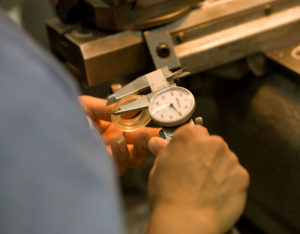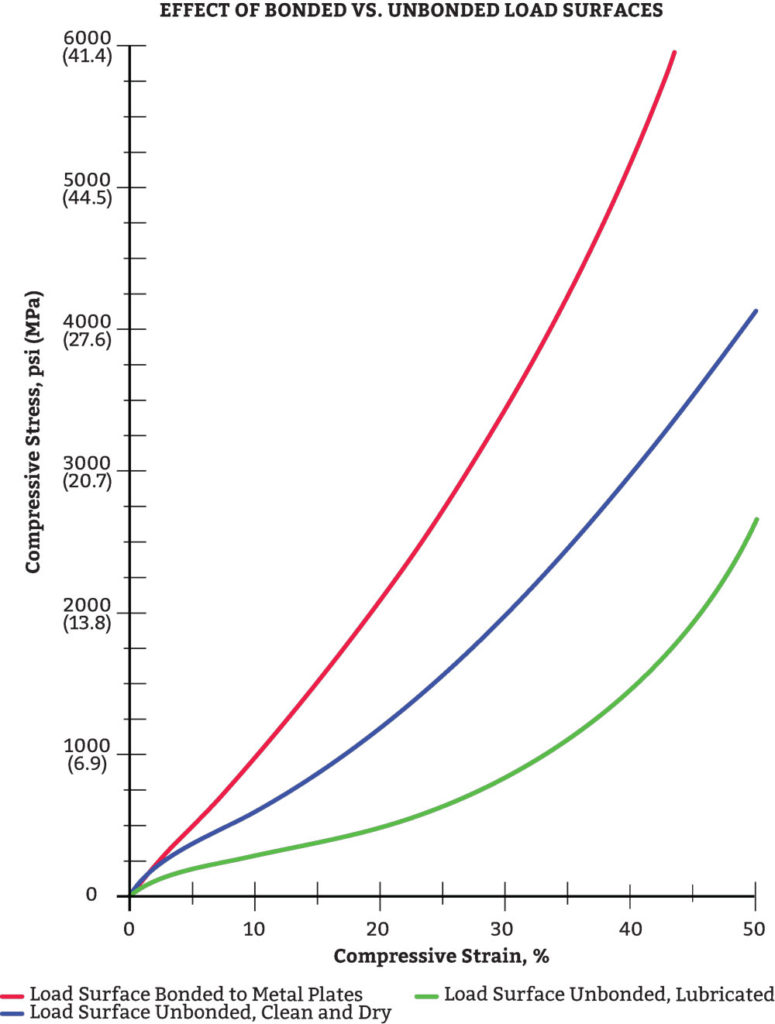Polyurethanes have an unusually high load-bearing capacity, and exhibit deflection and recovery capabilities that far exceed plastics or metals. Internally, polyurethanes have an elastic component that stores and returns energy, and a viscous component that captures and absorbs energy. We can tune the ratio of these components to create “lively” or “dead” compounds, depending on your use.
| Compression | Great for bumpers, pads, and bushings. Deflection response depends on shape and mounting conditions. |
| Torsion | E.g., springs. |
| Tension | When used in tension, polyurethane should only be used to a small fraction of its tensile strength — e.g., tethers. |
| Shear | Commonly used for mounting and suspension — e.g., mounting brackets and sprockets. |
Molded polyurethanes have excellent load-bearing capacity. When placed in compression urethanes can support higher loads than other elastomers of similar hardness. The high load capacity allows molded urethane components to be made smaller resulting in reduced weight and cost of raw materials. The magnitude of compressive force which can be supported by a given polyurethane compound is dependent on three main factors: hardness, loaded surface condition and shape factor.
Hardness
One of the most common ways to classify urethane elastomers is by hardness. Hardness is defined as the relative resistance of a surface to indentation by an indenter of specified dimension under a specified load. The most common way to measure hardness is with the use of a durometer. Durometers are used to assign a numerical hardness value based on the depth of penetration of the indenter. A harder polyurethane sample will be more resistant to indentation by the indenter and thus will give a higher durometer reading. The hardness range of elastomers is so broad that a single durometer cannot indicate practical measurable differences of hardness. For this reason, durometers are available in more than one scale. The A scale durometer is widely used throughout the rubber industry. The D scale durometer has a stiffer spring and a more pointed indenter; it’s used to measure the hardness of hard polyurethane.
 The typical hardness range for polyurethane compounds processed at Gallagher is 55A up to 80D; this range can be expanded based on specific applications. The A scale is used for softer compounds; at Gallagher, the A scale is used for compounds from 55A up to 95A. The D scale is used for harder compounds from 50D up to 80D. There is no linear relationship between the A scale and the D scale, however, a 95A is just slightly softer than a 50D. For comparison purposes, a rubber band is about a 35A, the tire tread on your car is about a 70A, the wheels of a roller skate are about 85A and a hard hat is about a 70D.
The typical hardness range for polyurethane compounds processed at Gallagher is 55A up to 80D; this range can be expanded based on specific applications. The A scale is used for softer compounds; at Gallagher, the A scale is used for compounds from 55A up to 95A. The D scale is used for harder compounds from 50D up to 80D. There is no linear relationship between the A scale and the D scale, however, a 95A is just slightly softer than a 50D. For comparison purposes, a rubber band is about a 35A, the tire tread on your car is about a 70A, the wheels of a roller skate are about 85A and a hard hat is about a 70D.
Hardness can be a useful indicator of how a polyurethane part will perform based on loads and deflections. Keep in mind, however, that many different prepolymer-curative combinations can be used to achieve the same hardness.
Hardness Scales. Note: the durometer “A” scale is used for the softer urethanes. The durometer “D” scale is used for the harder urethane compounds (above 95 A durometer).
Effect of Loaded Surface Condition
When a polyurethane part is deflected, any factor that influences the part’s ability to bulge will affect the stress-strain relationship. One such factor is the loading surface conditions. If a polyurethane part were compressed between two rigid parallel plates the urethane surfaces in contact with the plates would tend to spread out laterally under the load. If the plates were lubricated, this spreading occurs much easier than if the plates were clean and dry. If the urethane part was bonded to the plates then this spreading would be completely restricted. When the polyurethane surface in contact with the plates is not allowed to spread out under load, the total area of the part free to bulge is reduced. This effectively stiffens the part. The chart below shows three distinct compressive stress-strain relationships for the same piece of polyurethane with different loading surface conditions. The load bearing capability of polyurethane can be altered by a factor of 5 to 1 with this design consideration.
Effect of bonded vs. unbonded load surfaces on same compound and same shape factor. (click to enlarge)
Shape Factor
Shape factor is a term used to mathematically describe the shape of a part. It’s equal to the area of one loaded surface divided by the total area free to bulge.
The relationship is very important considering the fact that as a urethane part is compressed, it doesn’t decrease in volume. Thus, when the height of a part is decreased due to a compressive load, the sides of the part need to bulge out to maintain the volume. If the free area where this bulging takes places is reduced, the bulging action becomes more difficult and the compressive modulus of the part is increased.
Two parts, regardless of size, that are made of the same compound and have the same shape factor will behave similarly when loaded in compression. This is extremely helpful to the design engineer because large parts can be scaled down for easy testing in a laboratory environment. It’s also very important to note that the shape factor relationship is only plausible when the loaded surfaces of the polyurethane part are completely constricted from spreading out under the applied load. For loading conditions where the loaded surfaces are not constrained, load-deflection tests are required to fully understand the load-deflection relationship.
The shape factor for common load bearing applications will fall somewhere between 0.25 and 2. When shape factor decreases below 0.25 the part will be at a high risk of buckling. Much the same way a column in a building would buckle, if it were made too long and slender. When the shape factor gets much higher than 2, the effective compression modulus approaches the bulk modulus of the material. This is because there is very little surface free to bulge in relation to the loaded surface area.
The following examples show how a design engineer can use the concept of shape factor in conjunction with compression stress-strain curves to estimate the load-deflection characteristics for polyurethane parts.
Example 1
A systems engineer at a large power plant would like to use a urethane pad underneath a pump to isolate it from vibration. The urethane pad is 12 inches long by 6 inches wide by 1 inch thick and is bonded between ½ inch thick steel plates. The pump weighs 10,000 pounds and a 90 Shore A polyurethane compound was selected. In order to properly design the pipe supports adjacent to the pump, the engineer needs to know how much the pad will deflect under the 10,000-pound load.
a) The Shape Factor of the pad is:

b) The Compressive Stress is:
c) The Compressive Strain is found by using the stress-strain curve for 90 Shore A urethane at a 2.0 Shape Factor.
The Compressive Strain for 90 Shore A urethane at 139 psi with 2.0 shape factor is 3%.
d) The actual deflection of the pad is:
Example 2
An agricultural equipment company is experiencing failures in the field due to impact shock loading. The design engineer for that company has determined they can substantially increase the service life of the equipment by reducing the shock loading with polyurethane bumpers. The equipment will be retrofit with 6-inch diameter, 1-inch thick bumpers, with a 2-inch diameter hole in the middle for mounting purposes. The design engineer has determined they need 0.150 of an inch deflection to reduce the impact shock loading from 1,140,000 pounds down to 15,000 pounds (See the Impact Resistance section of this guide for an explanation on how this can be found). The design engineer would like to know what hardness urethane to use.
a) The shape factor for the bumper:
b) The Compressive Stress is:
c) The Required Strain is:
d) Using the shape factor curves, it can be found that 70 Shore A urethane will yield 15% when loaded to 600 psi at 1.0 shape factor.
Example 3
A commercial truck manufacturer is currently using polyurethane bumpers between the cab and frame to isolate vibration and shock loading. The bumper is 3 inches in diameter and 1 inch thick. A new luxury cab design is set to hit the market however due to added weight the polyurethane bumpers are overloaded. The truck manufacturer needs to accommodate the added weight, however, can’t alter the size or shape of the bumper due to universal mounting brackets. The truck manufacturer would also like to stay with the same compound because there isn’t sufficient time in the release schedule to fully test and validate a new compound in accordance with their corporate policy. Is there anything that can be done to accommodate this request?
a) The shape factor of the current bumper:
b) In order to accommodate a heavier weight a higher shape factor needs to be used. In order to raise the shape factor without changing the overall design, a sandwich bumper can be utilized. By bonding a rigid plate in the middle of the bumper the overall stiffness is increased.
c) Shape factor for the new sandwich design:
d) Now the overall deflection using the new shape factor will need to be multiplied by two to account for the two bumpers in series. The new overall deflection, however, will be less than the original deflection based on the original design.
Contact us for more information on polyurethane’s load-bearing capacity.

